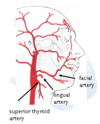Parotid Gand and Temporal Region Flashcards
(37 cards)
Parotid Gland
Acini, capsule, duct

Salivary gland with serous acini only
CT capsule and dense fibrous capsule extending as deep as the stylomandibular ligament
Single duct 1 fingers breadth below zygomatic arch

Parotid Duct

Sharp, medial turn to pierce buccal fat pad and buccinator to enter oral cavity.
Oblique passage
Palpable if masseter is tense

Facial Nerve to Muscles of Facial Expression


Facial Scructures


Parotid Gland and Surrounding Structures


Nerve Supply to Parotid Gland


Muscles of Mastication
Number
Four - Temporalis, masseter, medial pterygoid and lateral pterygoid
Muscles of Mastication
Innervation
Mandibular division of the trigeminal nerve (CN V3)
Muscles of Mastication
Function
Movements of the mandible - Elevation, depression, protrusion, retrusion and lateral sliding.
Depression may be by gravity or against force using supra-hyoid muscles
Temporalis
Attachments

Temporal fossa and fascia to coronoid process and anterior border of the ramus of the mandible

Covered by temporal fascia
Temporalis
Function

Anterior and superior fibres elevate mandible.
Posterior fibres retract it.

Temporalis
Innervation

Deep temporal nerves (x2) from anterior division of mandibular division of trigeminal nerve (CN V3)

Masseter
Attachments

Zygomatic arch to the lateral aspect of the ramus of the mandible

Masseter
Function

Elevates mandible

Masseter
Innervation

Masseteric nerve from the anterior division of CN V3

Lateral Pterygoid
Attachments (upper and lower head)

Upper head from the infratemporal surface of the greater wing of the sphenoid.
Lower head from the lateral surface of the lateral pterygoid plate
Insers into neck of mandible and articular disk

Lateral Pterygoid
Function

Pulls neck of mandible forwards with articular disk (Protrusion - both)
Helps in lateral chewing movements with Medial Pterygoid (one side)

Lateral Pterygoid
Innervation

Nerve to lateral pterygoid - anterior division of CN V3

Medial Pterygoid
Attachments (Superficial and Deep heads)

Superficial head from the tubercle of the maxilla
Deep head from the medial surface of the lateral pterygoid plate
Inserts into the medial surface of the angle of the mandible

Medial Pterygoid
Function

Assists in elevation

Medial Pterygoid
Innervation

Nerve to medial pterygoid from the main trunk of the mandibular division of the trigeminal nerve (CN V3)

Movements of the Mandible
Elevation
Head of the mandible and disc move backwards and head rotates on the lower surface of the disc (temporalis, masseter and medial pterygoid)
Movements of the Mandible
Depression
Head of mandible rotates on undersurface of articular disc and mandible is pulled forward (lateral pterygoid, digastric, geniohyoid, mylohyoid and gravity)
Movements of the Mandible
Protrustion
Articular disc and head of mandible move forward. Movement is in the upper part of the cavity (Lateral pterygoid and medial pterygoid which assists)
























